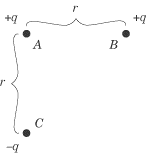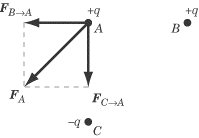Coulomb’s Law
Electric force is analogous to gravitational force: the attraction or repulsion
between two particles is directly proportional to the charge of the two
particles and inversely proportional to the square of the distance between them.
This relation is expressed mathematically as Coulomb’s Law:

Video Lesson - Coulombs Law
In this equation,
q1
and
q2
are the charges of the two particles, r
is the distance between them, and k
is a constant of proportionality. In a vacuum, this constant is Coulumb’s
constant,
ko,
which is approximately
9 × 109
N · m2 / C2. Coulomb’s constant is often expressed in
terms of a more fundamental constant—the permittivity of free space,
eo,
which has a value of
8.85 × 10-12
C2/ N · m2:

If they come up on Physics, the values for
ko
and
eo
will be given to you, as will any other values for
k when the electric force is acting in some other medium.
Example
|
Two particles, one with charge +q and the other with charge –q,
are a distance r apart. If the distance between the two particles is
doubled and the charge of one of the particles is doubled, how does the electric
force between them change? |
According to Coulomb’s Law, the electric force between the two particles is
initially
(Q).gif)
If we double one of the charges and double the value of
r, we find:
(q).gif)
Doubling the charge on one of the particles doubles the electric force, but
doubling the distance between the particles divides the force by four, so in
all, the electric force is half as strong as before.
Superposition
If you’ve got the hang of vectors, then you shouldn’t have too much trouble with
the law of superposition of electric forces. The net force acting on a
charged particle is the vector sum of all the forces acting on it. For instance,
suppose we have a number of charged particles,
q1,
q2,
and
q3.
The net force acting on
q1
is the force exerted on it by
q2
added to the force exerted on it by
q3.
More generally, in a system of n
particles:

where
 is the force exerted on particle 1 by
particle n and
F1
is the net force acting on particle 1. The
particle in the center of the triangle in the diagram below has no net force
acting upon it, because the forces exerted by the three other particles cancel
each other out.
is the force exerted on particle 1 by
particle n and
F1
is the net force acting on particle 1. The
particle in the center of the triangle in the diagram below has no net force
acting upon it, because the forces exerted by the three other particles cancel
each other out.

Example

In the figure above, what is the direction of the force acting on particle A?
The net force acting on A is the
vector sum of the force of B acting
on A and the force of
C acting on
A. Because they are both positive
charges, the force between A and
B is repulsive, and the force of
B on
A will act to push A
toward the left of the page. C will
have an attractive force on A and
will pull it toward the bottom of the page. If we add the effects of these two
forces together, we find that the net force acting on
A is diagonally down and to the
left.

Next to display next topic in the chapter.
Practice Questions
Video Lessons and 10 Fully Explained Grand Tests
Large number of solved practice MCQ with explanations. Video Lessons and 10 Fully explained Grand/Full Tests.